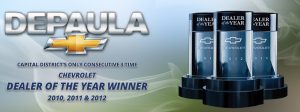Turnaround Specialist: A Dealer Shares 5 Secrets Behind His Used Vehicle Success
“We’re making more net profit in a month now than we used to make in an entire year. That speaks to two things…how bad we were before and how good we are now.”
This quote comes from Paul Lynch, the general sales manager at DePaula  Chevrolet, Albany, N.Y., who has led an impressive turnaround in the store’s used vehicle department over the past 15 months. Check out some of these results:
Chevrolet, Albany, N.Y., who has led an impressive turnaround in the store’s used vehicle department over the past 15 months. Check out some of these results:
Volume: The store has grown from selling an average 60 used vehicles/month, to an average 130/month.
Gross Profit: With the extra volume, the dealership’s front-end gross profit average has improved to nearly $1800/unit. Each sold unit also averages $1,000 in F&I and $350 in service gross profit.
Inventory: The store regularly maintains 80-plus percent or more of its inventory under 30 days of age (the benchmark I recommend is 50 percent), with none of the roughly 130-car inventory above 60 days old. The data indicate Lynch’s team retails most vehicles while they’re fresh and able to deliver maximum gross profit. This impressive turn-and-earn performance comes as the cost-to-market average for Lynch’s inventory hovers near 80 percent. “If our cost to market gets above 84 percent, we’re sounding the alarm,” he says.
Retail-Readiness: “If the cars aren’t done in the shop and pictured up and online in 72 hours, we feel very uncomfortable,” Lynch says. A streamlined process ensures reconditioning typically takes 24 hours or less, with an average cost of $700/unit.
I share Lynch’s results as an instructive example of a dealership that bit the bullet and decided “enough is enough” in used vehicles.
“We were in complete and utter disarray,” Lynch says. “It used to take us 16 days to get a car ready for retail. We had 90 cars over 90 days old. We weren’t really making any money because stuff would sit there. When it sold, it sold. It was like fake gross.”
Lynch says the turnaround his team achieved in used vehicles wasn’t easy. The initial clean-up of the store’s inventory resulted in $200,000 in losses and the effort required countless hours by managers to reinvent their processes to emphasize the time-is-money nature of today’s retail environment.
“It was a total culture change,” says Jay Newell, pre-owned sales manager. “But everybody’s on board and knows their role. Even the clean-up guy knows how fast we need to get cars online and ready.”
I asked Lynch to share highlights of the operational changes he undertook to help other dealers who aim to improve their used vehicle department performance and profitability. He offered five pointers:
1. Separate reconditioning team: The store’s previous 16-day reconditioning time average owed to the service department’s emphasis on customer pay work. The fix: Use a portion of the store’s body shop where three technicians and a writer focus solely on reconditioning used vehicles. They meet every morning to discuss their gameplan for each incoming car and ensure any repairs fall within initial estimates (if they don’t, the writer has a conversation with a manager).
2. Acquisition discipline: “We don’t buy or sell cars with bad CARFAX reports anymore,” Lynch says. Two buyers—one using online auctions the other at physical auctions—focus on acquiring vehicles with a low market days supply to ensure they sell quickly. The market days supply for the store’s inventory is under 70 days. This year, the dealership has expanded its acquisition “net,” acquiring vehicles from the Midwest and Southeast, a necessary step to maintain a pipeline of cars for its inventory.
3. Pricing Precision: Lynch’s managers review the price on every vehicle once a week for nearly four hours as a group. They focus on outliers—units that fall short of a 2 percent SRP/VDP conversion minimum on classified sites and those above 4 percent. They supplement the weekly review with daily checks of VDP conversions and adjust prices whenever they spot a need. “We’ve got multiple sets of eyes on our pricing,” Lynch says. “Some dealers may think we’re wasting our time on pricing. I think it’s the reason we’re not like everyone else. There’s a sweet spot for every single car and we’re always looking to be right there.”
4. Market-focused sales: Lynch’s team implemented a sales process that emphasizes each vehicle’s value proposition based on the market. Sales teams share comparison cars and prices with customers to underscore why the dealership’s asking price and vehicle represent a good deal. “Our sales team understands how and why we price our vehicles,” Lynch says. “We don’t work a deal with a customer until they’ve seen the evidence folders on every car. That’s what helps us hold gross.”
5. An “all-in” mentality: David Rinaldi, a performance manager who works with DePaula, has nicknamed Lynch “The Bulldog” for his tireless efforts to turn doubt into belief at the dealership. “If you don’t have everybody on board, understanding what you’re doing and why you’re doing it, you’re fighting an uphill battle,” Lynch says. “In a lot of dealerships, there’s animosity or dissension between departments. I think our biggest accomplishment was getting everyone to value the same things and march together in the same direction. You can’t get big results without that foundation.”
